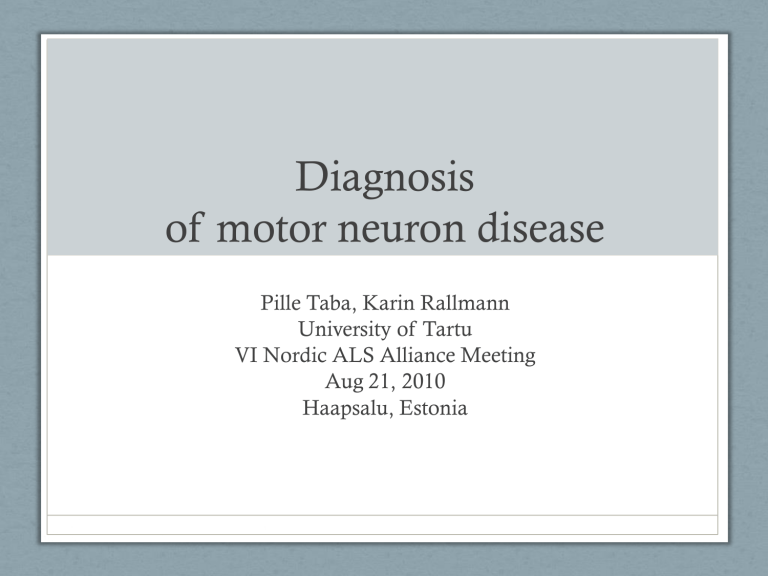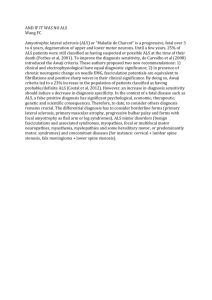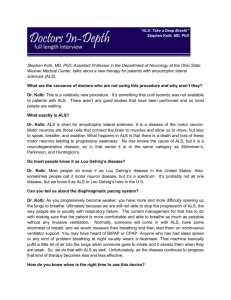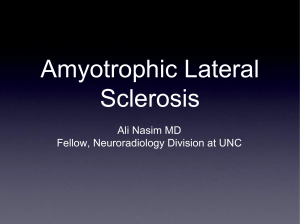Diagnosis of motor neuron disease

Diagnosis of motor neuron disease
Pille Taba, Karin Rallmann
University of Tartu
VI Nordic ALS Alliance Meeting
Aug 21, 2010
Haapsalu, Estonia
Motor neuron disease (MND)
• Charcot J-M. Sclerose des cordons lateraux de la moelle
epiniere … Bull Soc Med (Paris) 1865: 24-35.
− discussed clinic and pathology of a disorder that affected both upper and lower motor neuron
• Charcot disease
• Amyotrophic lateral sclerosis (ALS)
• Lou Gehrig disease (USA)
Motor pathway – upper and lower motor neuron
Motor neurons
Levels
• Bulbar – speech, swallowing
• Cervical – upper limbs
• Thoracic - trunk
• Lumbar – lower limbs
Motor neuron disease
Variants
Graaff et al 2009
Motor neuron disease
Epidemiology
• Incidence 1-3 cases per 100 000 per year
− In Estonia, incidence 1.3/ 100 000/ year
• Prevalence 6-8 per 100 000
• Mostly sporadic
• Less than 10% familiar
− About 20% of familiar ALS cases have SOD1 mutation
(Cu/Zn superoxide dismutase enzyme)
Burvill 2009
Gross-Paju et al 1998
Management of chronic disease
Diagnosis
• Early/ delay • Disease modifying
• Symptomatic
• Psychosocial care • Clinical signs
• Testing
• Information giving • Team approach
Diagnostic delay – why?
• Motor neuron disease – rare
• Variability of clinical picture
• Lack of diagnostic markers
• Delay of recognition of the disease by patient/ family or primary physician
• Time from the first symptoms to the confirmation of diagnosis – 14 months
Murray et al 2004
Swash 1999
Theoretical timeline
Motor function
Preclinical detectable genetically (?)
Identifiable by imaging, molecular markers (?)
Clinically overt disease
TIME
Eisen 2009
Basis of diagnosis – history and clinical signs
• Dysarthria, dysphagia, paucity of tongue movements
• Muscle weakness and wasting
• Hand dysfunction
• Foot drop
• Fasciculations/ cramps
• Spastic gait
• Respiratory failure
• Progressive course
Diagnostic criteria
• World Federation of Neurology, Subcommittee on
MND/ ALS El Escorial Revisited Criteria (1998)
• Clinically definite ALS: upper and lower motor neuron signs in three regions
• Clinically probable ALS: upper and lower motor neuron signs in two regions
• Clinically probably laboratory supported ALS: upper and lower motor neuron dysfunction in one region + EMG
• Clinically possible ALS: dysfunction in one region
• Suspected ALS: only lower motor neuron signs
Subcommittee on MND/ALS of WFN 1994; 1998
Symptoms to concern/ mimic syndromes
• Absence of fasciculations
• Sensory impairment
• Autonomic dysfunction
• Eye movement abnormalities
• Sphincter impairment
• Movement disorders
• Cognitive impairment (Alzheimer type)
• Symmetrical lower motor neuron signs
Mitchell 2007
Incorrect diagnosis
(initial diagnosis)
• Cervical myelopathy
• Multifocal motor neuropathy
• Multiple sclerosis (primary progressive)
• Radiculpathy (painless)
• Chronic inflammatory demyelinating polyneuropathy
• Myositis
• Cerebrovascular disease
• Periarthritis
Eisen 2009
Gross-Paju et al 1998
Differential diagnosis of ALS
• Muscle diseases
• Diseases of neuromuscular junction
• Diseases of anterior horn cells
• Diseases of spinal cord
• Diseases of central nervous system
• Systemic disorders
Differential diagnosis
• To exclude other causes of a slowly progressive spastic paraparesis
− Cervical disc
− Hereditary spastic paraplegia
− …
• Investigation
− Imaging: MRI – cervical, bulbar
− EMG
Confirming the diagnosis of MND/ ALS
Investigations: electroneuromyography
Investigations: imaging
• MRI – magnetic resonance imaging
• DTI – diffusion tensor imaging of the cortical spinal tract
• MR spectroscopy
− N-acetyl aspartate (NAA), marker for upper motor neuron degeneration
− myo-inositol (MI), marker for glial activity
MRI T2-weighted (FLAIR)
Graaff et al 2009
Investigations: laboratory sampling
• No specific biomarkers for confirming ALS
• For excluding different pathology
− Metabolic studies: blood chemistry
− Endocrinologic studies: thyroid function etc
− Screening monoclonal gammopathy: viruses
− CSF: exclude inflammatory processes
Functional scales – measuring change in status
• ALSFRS – ALS Functional Rating Scale
− To assess the more important activities
− Complete reliability and validity testing
• Norris Scale
• Appel Scale
− Additionally history
− Uses manual muscle testing (MMT)
• Tufts Quantitative Neuromuscular Exam
− Maximal voluntary isometric contraction
− Repetitive functional test
Munsat 1996
Swash 1999
Neurologist Family doctor
Neurophysiologist
Rehabilitation doctor
Nurse Patient
Physiotherapist
Dietician
Radiologist
Psychologist
Family
Carer
Occupational therapist
Social worker
Speech therapist











